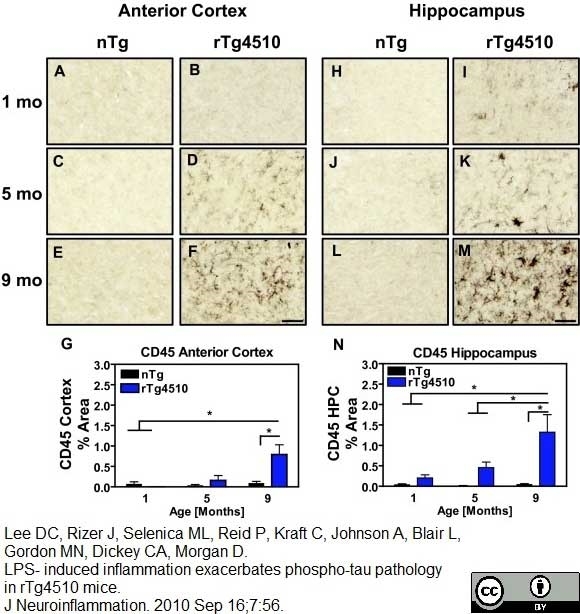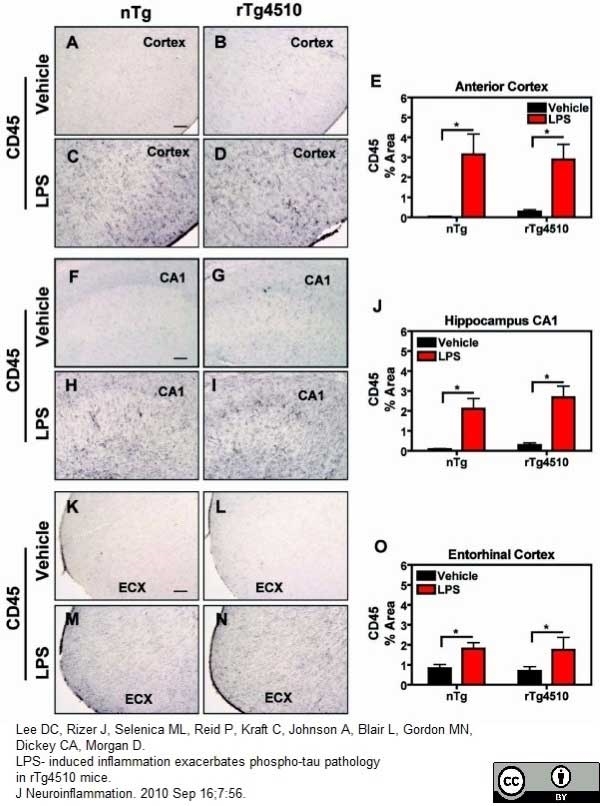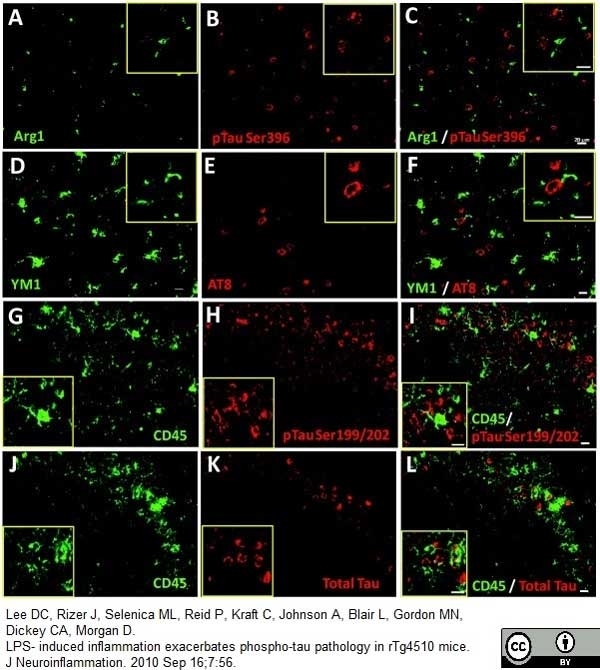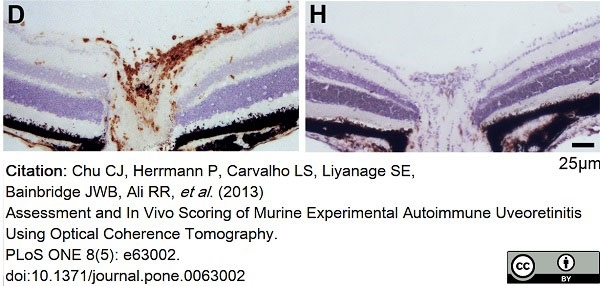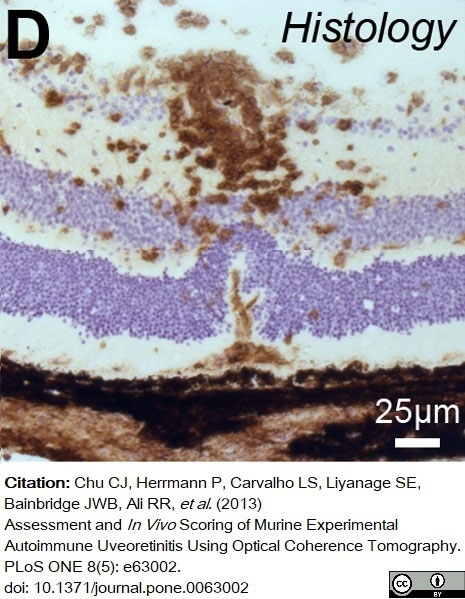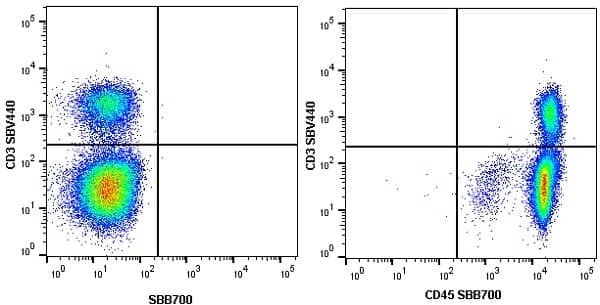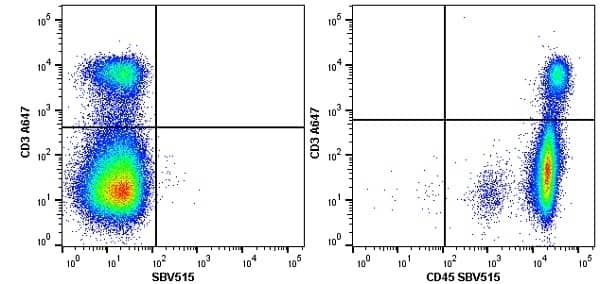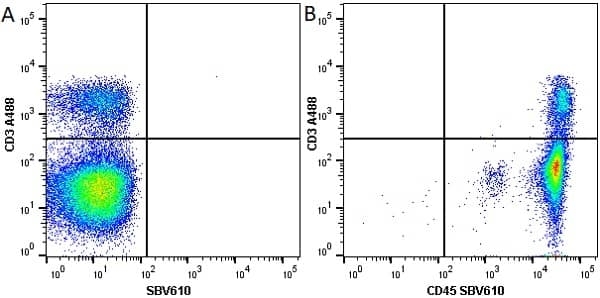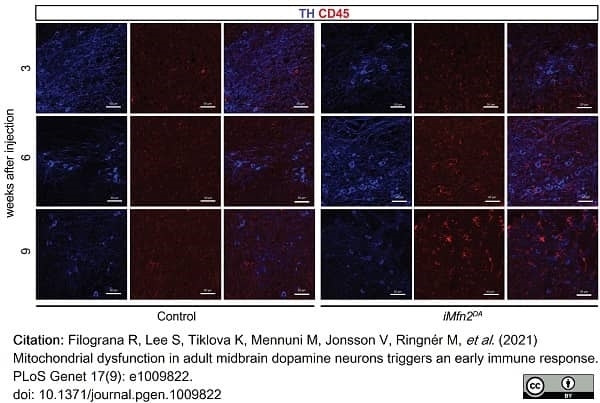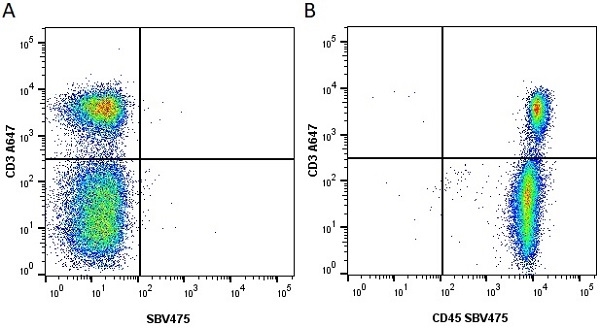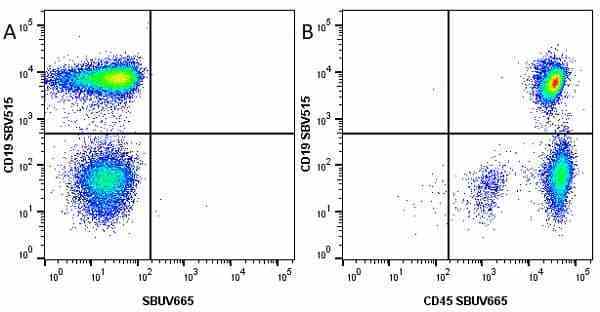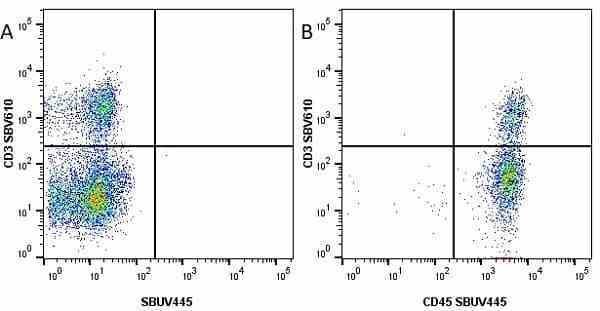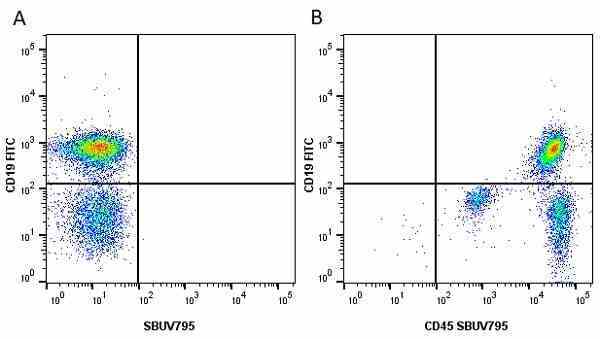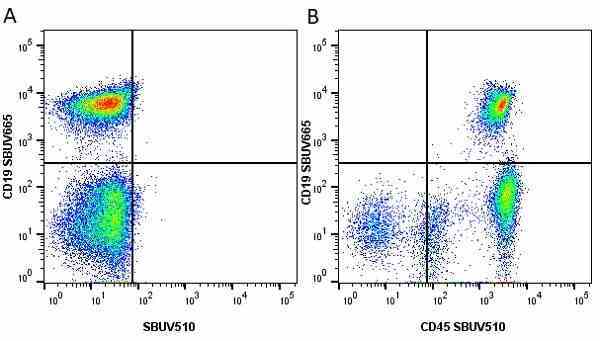CD45 antibody | YW62.3
















Rat anti Mouse CD45:Alexa Fluor® 488
- Product Type
- Monoclonal Antibody
- Clone
- YW62.3
- Isotype
- IgG2b
- Specificity
- CD45
| Rat anti Mouse CD45 antibody, clone YW62.3 recognizes the murine CD45 cell surface antigen, a single pass type1 transmembrane glycoprotein also known as protein tyrosine phosphatase receptor type C (PTPRC) and originally termed Leucocyte Common Antigen (LCA). CD45 is a 180-220kDa glycoprotein expressed by all leucocytes. CD45 is encoded by 3 alleles in mice, differentially expressed by various inbred strains. The Ly5 gene was originally described with the gene product LY5.1 expressed in C57bl/6 and Ly5.2 expressed in SJL strains (Komura et al. 1975), this was subsequently expanded to include a third allele encoding Ly5.3 (Shen et al. 1986). Further, in 1987 a reversal of nomenclature was instigated resulting in the allele in C57bl/6 becoming Ly5b encoding Ly5.2 and the allele in SJL mice becoming Ly5a encoding Ly5.1 (Morse et al. 1987). Further changes were made in 1992 with Ly5.1 becoming CD45.1 (SJL) and Ly5.2 becoming CD45.2 (C57bl/6). Finally, following work demonstrating homology between the CD45 antigen and a receptor linked protein tyrosine phosphatase the CD45a gene was renamed Ptprca and CD45b renamed Ptprcb (Charbonneau et al. 1988; Zebedee et al. 1991). A number of different isoforms of CD45 are expressed on murine leucocytes depending on the pattern of alternative splicing of 3 exons termed A, B and C encoding regions of ~ 50 amino acids located at the N terminal region of the extracellular portion of CD45. The restricted proteins are termed CD45R with a designation depending on the expressed codon product. (Birkeland et al. 1989). Rat anti mouse CD45 antibody, clone YW62.3 is reactive with all isoforms of murine CD45. N.B. Some reactivity with human tissue has been observed. |
- Target Species
- Mouse
- Product Form
- Purified IgG conjugated to Alexa Fluor 488 - liquid
- Preparation
- Purified IgG prepared by affinity chromatography on Protein G from tissue culture supernatant
- Buffer Solution
- Phosphate buffered saline
- Preservative Stabilisers
- 0.09% sodium azide (NaN3)
1% bovine serum albumin - Immunogen
- Mouse spleen cells.
- Approx. Protein Concentrations
- IgG concentration 0.05 mg/ml
- Fusion Partners
- Spleen cells from immunised DA rats were fused with cells of the rat Y3/Ag1.2.3 myeloma cell line.
- Max Ex/Em
-
Fluorophore Excitation Max (nm) Emission Max (nm) Alexa Fluor®488 495 519 - Regulatory
- For research purposes only
- Guarantee
- 12 months from date of despatch
- Acknowledgements
- This product is provided under an intellectual property licence from Life Technologies Corporation. The transfer of this product is contingent on the buyer using the purchase product solely in research, excluding contract research or any fee for service research, and the buyer must not sell or otherwise transfer this product or its components for (a) diagnostic, therapeutic or prophylactic purposes; (b) testing, analysis or screening services, or information in return for compensation on a per-test basis; (c) manufacturing or quality assurance or quality control, or (d) resale, whether or not resold for use in research. For information on purchasing a license to this product for purposes other than as described above, contact Life Technologies Corporation, 5791 Van Allen Way, Carlsbad CA 92008 USA or outlicensing@thermofisher.com
Avoid repeated freezing and thawing as this may denature the antibody. Storage in frost-free freezers is not recommended. This product is photosensitive and should be protected from light.
| Application Name | Verified | Min Dilution | Max Dilution |
|---|---|---|---|
| Flow Cytometry | Neat |
References for CD45 antibody
-
Watt, S.M. et al. (1987) Cell-surface markers on haemopoietic precursors. Reagents for the isolation and analysis of progenitor cell subpopulations.
Mol Cell Probes. 1 (4): 297-326. -
Kondo, Y. et al. (2007) Osteopetrotic (op/op) mice have reduced microglia, no Abeta deposition, and no changes in dopaminergic neurons.
J Neuroinflammation. 4: 31. -
Wang, S. et al. (2008) Drak2 contributes to West Nile virus entry into the brain and lethal encephalitis.
J Immunol. 181: 2084-91. -
Chan, D.A. et al (2009) Tumor vasculature is regulated by PHD2-mediated angiogenesis and bone marrow-derived cell recruitment.
Cancer Cell. 15: 527-38. -
Lee, S. et al. (2010) CX3CR1 deficiency alters microglial activation and reduces beta-amyloid deposition in two Alzheimer's disease mouse models.
Am J Pathol. 177: 2549-62. -
Dénes, A. et al. (2010) Chronic systemic infection exacerbates ischemic brain damage via a CCL5 (regulated on activation, normal T-cell expressed and secreted)-mediated proinflammatory response in mice.
J Neurosci. 30: 10086-95. -
Yoshizaki, A. et al. (2010) Cell adhesion molecules regulate fibrotic process via Th1/Th2/Th17 cell balance in a bleomycin-induced scleroderma model.
J Immunol. 185: 2502-15. -
Yang, J. et al. (2010) Evaluation of bone marrow- and brain-derived neural stem cells in therapy of central nervous system autoimmunity.
Am J Pathol. 177: 1989-2001.
View The Latest Product References
-
Yang, R. et al. (2010) Successful treatment of experimental glomerulonephritis with IdeS and EndoS, IgG-degrading streptococcal enzymes.
Nephrol Dial Transplant. 25: 2479-86. -
Reed-Geaghan, E.G. et al. (2010) Deletion of CD14 attenuates Alzheimer's disease pathology by influencing the brain's inflammatory milieu.
J Neurosci. 30: 15369-73. -
Paz, H. et al. (2010) The homeobox gene Hhex regulates the earliest stages of definitive hematopoiesis.
Blood. 116: 1254-62. -
Lee, D.C. et al. (2010) LPS- induced inflammation exacerbates phospho-tau pathology in rTg4510 mice.
J Neuroinflammation. 7: 56. -
Lebson, L. et al. (2010) Trafficking CD11b-positive blood cells deliver therapeutic genes to the brain of amyloid-depositing transgenic mice.
J Neurosci. 30: 9651-8. -
Long, G.G. et al. (2010) Hematopoietic Proliferative Lesions in the Spleen of rasH2 Transgenic Mice Treated with MNU.
Toxicol Pathol. 38: 1026-36. -
Drake, C. et al. (2011) Brain inflammation is induced by co-morbidities and risk factors for stroke.
Brain Behav Immun. 25: 1113-22. -
Jawhara, S. et al. (2012) Integrin αXβz is a leukocyte receptor for Candida albicans and is essential for protection against fungal infections.
J Immunol. 189 (5): 2468-77. -
Mills, J.H. et al. (2012) A2A adenosine receptor signaling in lymphocytes and the central nervous system regulates inflammation during experimental autoimmune encephalomyelitis.
J Immunol. 188 (11): 5713-22. -
Zirger, J.M. et al. (2012) Immune-mediated loss of transgene expression from virally transduced brain cells is irreversible, mediated by IFNγ, perforin, and TNFα, and due to the elimination of transduced cells.
Mol Ther. 20 (4): 808-19. -
Yamauchi, S. et al. (2012) Myosin II-dependent exclusion of CD45 from the site of Fcγ receptor activation during phagocytosis.
FEBS Lett. 586: 3229-35. -
Abramowski, D. et al. (2012) Transgenic Expression of Intraneuronal Aβ42 But Not Aβ40 Leads to Cellular Aβ Lesions, Degeneration, and Functional Impairment without Typical Alzheimer's Disease Pathology.
J Neurosci. 32: 1273-83. -
Chu, C.J. et al. (2013) Assessment and in vivo scoring of murine experimental autoimmune uveoretinitis using optical coherence tomography.
PLoS One. 8 (5): e63002. -
Murinello, S. et al. (2014) Fcγ receptor upregulation is associated with immune complex inflammation in the mouse retina and early age-related macular degeneration.
Invest Ophthalmol Vis Sci. 55 (1): 247-58. -
Yazid, S. et al. (2015) Annexin-A1 restricts Th17 cells and attenuates the severity of autoimmune disease.
J Autoimmun. 58: 1-11. -
Benson, C. et al. (2015) Voluntary wheel running delays disease onset and reduces pain hypersensitivity in early experimental autoimmune encephalomyelitis (EAE).
Exp Neurol. 271: 279-90. -
Carbajal, K.S. et al. (2015) Th Cell Diversity in Experimental Autoimmune Encephalomyelitis and Multiple Sclerosis.
J Immunol. 195 (6): 2552-9. -
Kan, M.J. et al. (2015) Arginine deprivation and immune suppression in a mouse model of Alzheimer's disease.
J Neurosci. 35 (15): 5969-82. -
Marcos, E. et al. (2016) Dengue encephalitis-associated immunopathology in the mouse model: Implications for vaccine developers and antigens inducer of cellular immune response.
Immunol Lett. 176: 51-6. -
Haile, W.B. et al. (2016) The Janus kinase inhibitor ruxolitinib reduces HIV replication in human macrophages and ameliorates HIV encephalitis in a murine model.
Neurobiol Dis. 92 (Pt B): 137-43. -
Park, S.A. et al. (2016) Deficiency in either COX-1 or COX-2 genes does not affect amyloid beta protein burden in amyloid precursor protein transgenic mice.
Biochem Biophys Res Commun. 478 (1): 286-92. -
Srivastava, A.K. et al. (2016) Co-transplantation of syngeneic mesenchymal stem cells improves survival of allogeneic glial-restricted precursors in mouse brain.
Exp Neurol. 275 Pt 1: 154-61. -
Zhu, C. et al. (2020) Antinociceptive effect of intrathecal injection of miR-9-5p modified mouse bone marrow mesenchymal stem cells on a mouse model of bone cancer pain.
J Neuroinflammation. 17 (1): 85. -
Hargreaves, A. et al. (2021) Tumors modulate fenestrated vascular beds and host endocrine status.
J Appl Toxicol. 41 (12): 1952-65. -
Filograna, R. et al. (2021) Mitochondrial dysfunction in adult midbrain dopamine neurons triggers an early immune response.
PLoS Genet. 17 (9): e1009822. -
Hargreaves, A. et al. (2022) Tumours modulate the systemic vascular response to anti-angiogenic therapy.
J Appl Toxicol. 42 (8): 1371-84. -
Chen, Y.H. et al. (2020) Functionally distinct IFN-γ(+) IL-17A(+) Th cells in experimental autoimmune uveitis: T-cell heterogeneity, migration, and steroid response.
Eur J Immunol. 50 (12): 1941-51.
- Synonyms
- LCA
- RRID
- AB_808435
- UniProt
- P06800
- Entrez Gene
- Ptprc
- GO Terms
- GO:0000187 activation of MAPK activity
- GO:0001915 negative regulation of T cell mediated cytotoxicity
- GO:0001916 positive regulation of T cell mediated cytotoxicity
- GO:0001960 negative regulation of cytokine-mediated signaling pathway
- GO:0002925 positive regulation of humoral immune response mediated by circulating immunoglobulin
- GO:0051726 regulation of cell cycle
- GO:0004725 protein tyrosine phosphatase activity
- GO:0005887 integral to plasma membrane
- GO:0005925 focal adhesion
- View More GO Terms
- GO:0006469 negative regulation of protein kinase activity
- GO:0006470 protein dephosphorylation
- GO:0007159 leukocyte cell-cell adhesion
- GO:0008201 heparin binding
- GO:0009897 external side of plasma membrane
- GO:0019901 protein kinase binding
- GO:0030183 B cell differentiation
- GO:0030890 positive regulation of B cell proliferation
- GO:0031953 negative regulation of protein autophosphorylation
- GO:0034113 heterotypic cell-cell adhesion
- GO:0042098 T cell proliferation
- GO:0042100 B cell proliferation
- GO:0043065 positive regulation of apoptosis
- GO:0043395 heparan sulfate proteoglycan binding
- GO:0043410 positive regulation of MAPKKK cascade
- GO:0045059 positive thymic T cell selection
- GO:0045060 negative thymic T cell selection
- GO:0045121 membrane raft
- GO:0045577 regulation of B cell differentiation
- GO:0045588 positive regulation of gamma-delta T cell differentiation
- GO:0046641 positive regulation of alpha-beta T cell proliferation
- GO:0048304 positive regulation of isotype switching to IgG isotypes
- GO:0050732 negative regulation of peptidyl-tyrosine phosphorylation
- GO:0050852 T cell receptor signaling pathway
- GO:0050853 B cell receptor signaling pathway
- GO:0050855 regulation of B cell receptor signaling pathway
- GO:0050857 positive regulation of antigen receptor-mediated signaling pathway
- GO:0051209 release of sequestered calcium ion into cytosol
- GO:0051607 defense response to virus
MCA1031A488
If you cannot find the batch/lot you are looking for please contact our technical support team for assistance.
Please Note: All Products are "FOR RESEARCH PURPOSES ONLY"
View all Anti-Mouse ProductsAlways be the first to know.
When we launch new products and resources to help you achieve more in the lab.
Yes, sign me up
